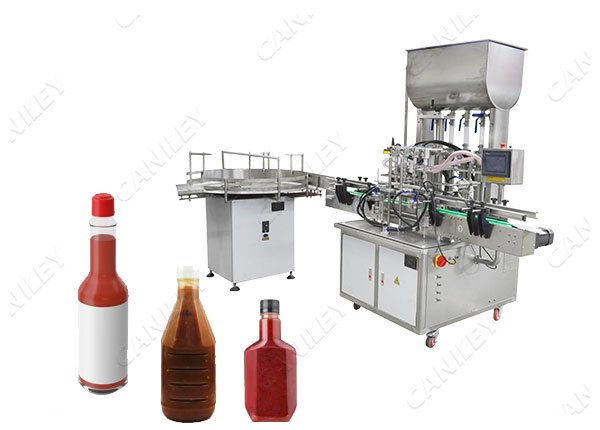How Does The Automatic Bottle Filling Machine Work?
- Release Lime: Jun 25 2023
- Source: Sherry
In today's fast-paced manufacturing industry, efficiency and precision are crucial factors in optimizing production processes. One such process is bottle filling, which has evolved significantly with the advent of automatic bottle filling machines. These machines have revolutionized the manufacturing industry by streamlining the process of filling bottles with liquids or granular substances. But do you know how does the automatic bottle filling machine work?

Conveyor system:
Automatic bottle filling machines typically feature a conveyor system that transports empty bottles to the filling station. The conveyor moves the bottles in an organized manner, ensuring a steady flow of containers for efficient filling. This conveyor system can be composed of belts, rollers, or chains, depending on the specific machine design.
Bottle orientation and positioning:
Before the filling process begins, it is essential to ensure that the bottles are correctly oriented and positioned. Automatic bottle filling machines employ various mechanisms, such as sensors, guides, and mechanical arms, to align the bottles properly. These mechanisms help ensure that the bottles are in the right position and ready to receive the desired substance.
Filling mechanism:
The most important of the automatic bottle filling machine lies in its filling mechanism. There are different types of filling mechanisms used, depending on the nature of the substance being dispensed. Some commonly employed methods include:
a. Gravity filling: In gravity filling systems, the liquid or granular substance flows into the bottles under the influence of gravity. The machine controls the flow rate by adjusting the height of the filling nozzle or valve.
b. Pressure filling: Pressure filling systems use a positive pressure source, such as compressed air, to force the substance into the bottles. This method is often employed for carbonated beverages or products that require a precise fill level.
c. Vacuum filling: Vacuum filling relies on creating a partial vacuum inside the bottle, causing the liquid to be drawn into the container.
d. Piston filling: Piston filling systems utilize a piston and cylinder arrangement to draw and dispense the substance into the bottles. The piston creates a precise volume control, making it suitable for filling a wide range of products.
Control systems:
Automatic bottle filling machines incorporate advanced control systems to ensure accurate and consistent filling. These control systems may involve programmable logic controllers (PLCs) or microcontrollers, which regulate the timing, flow rate, and other parameters of the filling process. Sensors and feedback mechanisms provide real-time data, enabling the machine to adjust settings as needed and maintain optimal performance.
Capping and sealing:
Once the bottles are filled, they proceed to the capping or sealing station. Automatic bottle filling machines often integrate capping mechanisms that secure the bottles with caps, lids, or seals. These mechanisms can involve threading, snap-on caps, induction sealing, or other sealing methods, depending on the product requirements.
Quality control:
To ensure product quality, automatic bottle filling machines may incorporate quality control measures. These measures can include vision systems that inspect the filled bottles for defects, such as improper fill levels or missing caps. Any faulty bottles are typically rejected and removed from the production line.

Conveyor system:
Automatic bottle filling machines typically feature a conveyor system that transports empty bottles to the filling station. The conveyor moves the bottles in an organized manner, ensuring a steady flow of containers for efficient filling. This conveyor system can be composed of belts, rollers, or chains, depending on the specific machine design.
Bottle orientation and positioning:
Before the filling process begins, it is essential to ensure that the bottles are correctly oriented and positioned. Automatic bottle filling machines employ various mechanisms, such as sensors, guides, and mechanical arms, to align the bottles properly. These mechanisms help ensure that the bottles are in the right position and ready to receive the desired substance.
Filling mechanism:
The most important of the automatic bottle filling machine lies in its filling mechanism. There are different types of filling mechanisms used, depending on the nature of the substance being dispensed. Some commonly employed methods include:
a. Gravity filling: In gravity filling systems, the liquid or granular substance flows into the bottles under the influence of gravity. The machine controls the flow rate by adjusting the height of the filling nozzle or valve.
b. Pressure filling: Pressure filling systems use a positive pressure source, such as compressed air, to force the substance into the bottles. This method is often employed for carbonated beverages or products that require a precise fill level.
c. Vacuum filling: Vacuum filling relies on creating a partial vacuum inside the bottle, causing the liquid to be drawn into the container.
d. Piston filling: Piston filling systems utilize a piston and cylinder arrangement to draw and dispense the substance into the bottles. The piston creates a precise volume control, making it suitable for filling a wide range of products.
Control systems:
Automatic bottle filling machines incorporate advanced control systems to ensure accurate and consistent filling. These control systems may involve programmable logic controllers (PLCs) or microcontrollers, which regulate the timing, flow rate, and other parameters of the filling process. Sensors and feedback mechanisms provide real-time data, enabling the machine to adjust settings as needed and maintain optimal performance.
Capping and sealing:
Once the bottles are filled, they proceed to the capping or sealing station. Automatic bottle filling machines often integrate capping mechanisms that secure the bottles with caps, lids, or seals. These mechanisms can involve threading, snap-on caps, induction sealing, or other sealing methods, depending on the product requirements.
Quality control:
To ensure product quality, automatic bottle filling machines may incorporate quality control measures. These measures can include vision systems that inspect the filled bottles for defects, such as improper fill levels or missing caps. Any faulty bottles are typically rejected and removed from the production line.

 0086-15515573212
0086-15515573212 info@cankeytech.com
info@cankeytech.com



 Your Location:
Your Location: